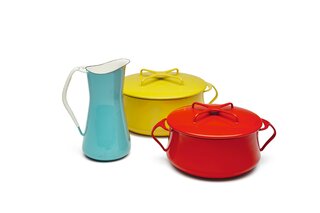The Story of Scandinavian Design Isn’t What You Think It Is
A new LACMA exhibit explores the influence of the region on American design, setting aside greige minimalism and celebrating curves, vibrant hues, and verve.

A new LACMA exhibit explores the influence of the region on American design, setting aside greige minimalism and celebrating curves, vibrant hues, and verve.
At the Los Angeles County Museum of Art, a new exhibition featuring Nordic design from the previous century includes dozens of objects you likely already know and love: a Finn Juhl chair, sleek and modernist; 1960s Marimekko textiles with bright florals; and Alvar Aalto’s glass Iittala vase, with its sinuous contours. There are also late 19th- and early 20th-century works that, predating midcentury modernism, are more ornate and likely less familiar: wooden chairs and iron punch bowls inscribed with lace patterns, vikings, and dragons, and hand-woven tapestries and elaborate jewelry. And finally, the show includes more than a handful of presumably American items you might be surprised to find there at all, like Lego sets, Eames chairs, and Fiskars scissors.

The Los Angeles County Museum of Art’s latest exhibit features works from 1890-1980 by Scandinavian designers and their American counterparts. The museum commissioned Barbara Bestor Architects for show’s colorful design.
Photo © Museum Associates/LACMA
At its heart, Scandinavian Design and the United States, 1890–1980, on view at LACMA through February 5 of 2023, is an exhibition focused on the immigrant designers and craftspeople from Denmark, Sweden, Finland, Norway, and Iceland who "played an enormous role in shaping American design," says LACMA’s Bobbye Tigerman, who cocurated the exhibit with Monica Obniski of the Milwaukee Art Museum.
The exhibition, designed by Los Angeles architect Barbara Bestor, serves as a follow up to Tigerman’s book of the same name, released in 2020, which is packed with examples of Scandinavian design influences on America. Charles and Ray Eames, for example, owe some credit to Finnish architect Eliel Saarinen, who, like many Nordic immigrants, arrived in the American midwest early in the twentieth century. Saarinen designed both the campus and academia of Cranbrook Academy of Art outside Detroit, Michigan, inviting other Nordic immigrants, including ceramicist Maija Grotell and weaver Marianne Strengell, to join the faculty. The school eventually became the incubator of some of the most acclaimed American designers, including the Eameses, Florence Knoll, and many others.

Marimekko textiles are a few of the familiar favorites included in the exhibition.
Photo © Museum Associates/LACMA

A collection of midcentury-modern seating that includes Eero Saarinen’s Tulip chair and an Eames Molded Plastic armchair highlights the dialogue that was happening between American and Nordic designers.
Photo © Museum Associates/LACMA
See the full story on Dwell.com: The Story of Scandinavian Design Isn’t What You Think It Is
Related stories:
